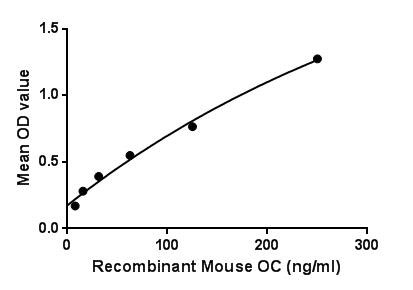Active Osteocalcin (OC)
BGLAP; OT; BGP; Bone Gla Protein; Bone Gamma-Carboxyglutamate Protein; Gamma-carboxyglutamic acid-containing protein
- Product No.APA471Mu01
- Organism SpeciesMus musculus (Mouse) Same name, Different species.
- Buffer Formulation20mM Tris, 150mM NaCl, pH8.0, containing 1mM EDTA, 1mM DTT, 0.01% SKL, 5% Trehalose and Proclin300.
- TraitsFreeze-dried powder
- Purity> 95%
- Isoelectric Point6.3
- ApplicationsCell culture; Activity Assays.
- Download Instruction Manual
- UOM 10µg50µg 200µg 1mg 5mg
-
FOB
US$ 310
For more details, please contact local distributors!US$ 774
For more details, please contact local distributors! US$ 1548
For more details, please contact local distributors! US$ 4644
For more details, please contact local distributors! US$ 11610
For more details, please contact local distributors!
ACTIVITY TEST of the Active Osteocalcin (OC)

Figure. The binding activity of OC with FUR.
Osteocalcin (OC), also known as bone gamma-carboxyglutamic acid-containing protein (BGLAP), is a noncollagenous protein hormone found in bone and dentin. Osteocalcin is secreted solely by osteoblasts and thought to play a role in the body's metabolic regulation and is pro-osteoblastic, or bone-building, by nature. It is also implicated in bone mineralization and calcium ion homeostasis. Osteocalcin acts as a hormone in the body, causing beta cells in the pancreas to release more insulin, and at the same time directing fat cells to release the hormone adiponectin, which increases sensitivity to insulin. Besides, Furin (FUR) has been identified as an interactor of OC, thus a binding ELISA assay was conducted to detect the interaction of recombinant mouse OC and recombinant mouse FUR. Briefly, OC were diluted serially in PBS, with 0.01% BSA (pH 7.4). Duplicate samples of 100μl were then transferred to FUR-coated microtiter wells and incubated for 2h at 37℃. Wells were washed with PBST and incubated for 1h with anti-OC pAb, then aspirated and washed 3 times. After incubation with HRP labelled secondary antibody, wells were aspirated and washed 3 times. With the addition of substrate solution, wells were incubated 15-25 minutes at 37℃. Finally, add 50µL stop solution to the wells and read at 450nm immediately. The binding activity of OC and FUR was shown in Figure 1, and this effect was in a dose dependent manner.
USAGE of the Active Osteocalcin (OC)
Reconstitute in 20mM Tris, 150mM NaCl (pH8.0) to a concentration of 0.1-1.0 mg/mL. Do not vortex.
STORAGE of the Active Osteocalcin (OC)
Avoid repeated freeze/thaw cycles. Store at 2-8°C for one month. Aliquot and store at -80°C for 12 months.
STABILITY of the Active Osteocalcin (OC)
The thermal stability is described by the loss rate. The loss rate was determined by accelerated thermal degradation test, that is, incubate the protein at 37°C for 48h, and no obvious degradation and precipitation were observed. The loss rate is less than 5% within the expiration date under appropriate storage condition.
INCREMENT SERVICES
BCA Protein Quantification Kit
Molecular Mass Marker for Protein
Monoclonal Antibody Customized Service
Polyclonal Antibody Customized Service
Protein Activity Test Experiment Service
Electrophoretic Mobility Shift Assay (EMSA) Experiment Service
Buffer
Lentivirus Packaging Experiment Service
Adenovirus Packaging Experiment Service
Real Time PCR Experimental Service
Spike RBD Protein (S-RBD)
Protein G
Protein A
Related products
| Catalog No. | Organism species: Mus musculus (Mouse) | Applications (RESEARCH USE ONLY!) |
| RPA471Mu02 | Recombinant Osteocalcin (OC) | Positive Control; Immunogen; SDS-PAGE; WB. |
| APA471Mu01 | Active Osteocalcin (OC) | Cell culture; Activity Assays. |
| RPA471Mu01 | Recombinant Osteocalcin (OC) | Positive Control; Immunogen; SDS-PAGE; WB. |
| PAA471Mu02 | Polyclonal Antibody to Osteocalcin (OC) | WB; IHC; ICC; IP. |
| PAA471Mu01 | Polyclonal Antibody to Osteocalcin (OC) | WB; IHC; ICC; IP. |
| MEA471Mu | Mini Samples ELISA Kit for Osteocalcin (OC) | Enzyme-linked immunosorbent assay for Antigen Detection. |
| IEA471Mu | Instant ELISA Kit for Osteocalcin (OC) | Enzyme-linked immunosorbent assay for Antigen Detection. |
| SEA471Mu | ELISA Kit for Osteocalcin (OC) | Enzyme-linked immunosorbent assay for Antigen Detection. |
| LMA471Mu | Multiplex Assay Kit for Osteocalcin (OC) ,etc. by FLIA (Flow Luminescence Immunoassay) | FLIA Kit for Antigen Detection. |
| KSA471Mu01 | ELISA Kit DIY Materials for Osteocalcin (OC) | Main materials for "Do It (ELISA Kit) Yourself". |

